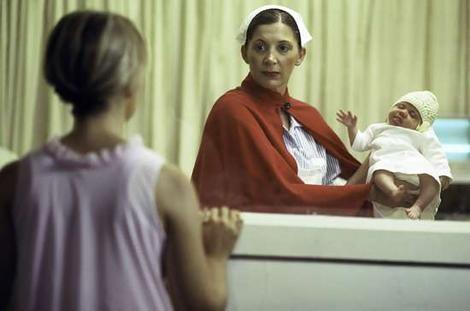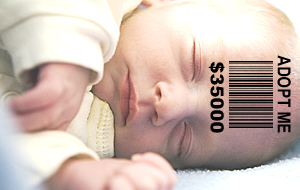What Happens to the Numbers of Adoptable Infants in the USA if We Compare to Australia?
I know we did this years back, but I can’t find the numbers we crunched anymore. So I did it again since I keep on referencing figures that are covered in memory dust. I am a fan of facts.
Australia has long been known to be a model for adoption reform which is kind of amusing since they modeled their original adoption practices off of the USA. They both have their history in forced adoptions, genocide, eugenics, etc, and follow very similar patterns in both the growth of domestic infant adoptions and population curves.
We do have two major differences between the USA and Australia in Adoption and Culturally;
- Australia, perhaps due to the media attention over the Stolen Generations, had the influence of adoption advocacy starting the mid 1970’s. While the US has had people speaking out and desiring to overturn the secrecy of sealed adoption records being at that time frame as well, in Australia, the governments actually listened and change laws. Now I will admit that I get confused about the “states” in Aussie-land, but New South Wales opened their adoption records in 1976 and was followed by other states in the country.
Then most of the country took it a step further and that resulted in a complete overhaul of the practice of adoption most specifically in regard to the act of relinquishment.
- There are no private adoptions at all in the country, but rather the government oversees all adoptions.
- There are no agencies or lawyer of adoption facilitators or other professionals who make a profit from the transaction of parental rights.
- There is no pre birth matching or contact between the expectant parents and prospective adoptive parents.
- There is no relinquishment before birth and birthparents have a full 30 days to revoke consent.
- Both fathers and mothers are needed to consent
- There is mandatory counseling and people are encouraged to parent.
I find it pretty clear to compare, say, a typical ‘Thinking about Adoption” American Agency website versus an Australian state run “Parents Considering Adoption for your Child” website. By the way, this US agency I picked as I typed out one word “Pregnant” in Google and this was the first site that came up.
- The other BIG difference between the US and Australia in terms of their adoption numbers is that Auz is much more of a socially conscious country. They honor the bonds between mothers and children and have social policy that supports parenting. For instance the Supporting Mothers Benefit was introduced in 1973. The Supporting Mothers Benefit which was increased to also include single fathers allows a mother to know that she has income to stay home and care for her child until that child reaches school age. It’s kind of like what Welfare in this country SHOULD be, but I don’t think that the Australians hate seeing other people live off their taxes quite as much as we do in the USA. They have socialized medical care there, too.
So before we get to number crunching, the differences are that in Australia there is no longer profit in adoption and mothers are encouraged to parent including having support provided by the country which recognizes the importance of child rearing, time to be mothers before they can relinquish and no emotional connections to the adoptive parents before they can make an informed choice.
What was the Outcome in Terms of Adoption Rates?
So much like the USA, adoption rates, specifically domestic infant relinquishments from unwed mothers, reached their peaks in 1970. I can’t find a nice chart for the USA, but the number of adoptions by unrelated petitioners declined from a high of 89,200 in 1970 to 47,700 in 1975 which would match the nice chart for Australia and document the decreases.
Now in the USA the decrease in the number of adoptions is usually contributed to the legalization of abortion in 1973 with Roe versus Wade. However, Australia had not criminalized the act and accepted abortion a bit earlier depending on the state. Both countries did see the same acceptance of single motherhood including divorce rates in the early 70’s.
Number of adoptions in Australia from 1968-69 to 2010-11
The numbers of Voluntary Domestic Infant Adoptions in Australia has obviously greatly decreased. So time to compare. I went and dug up stats on numbers of Voluntary Domestic Infant Relinquishments in both countries for different time frames. I also researched the overall populations of the countries to account for natural growth numbers. As the USA has a much greater overall population than Australia, it is necessary to adjust the numbers to get an accurate representation and to be able to compare apples to apples.
Now there is not a corresponding government body in the USA that accurately counts the numbers of women who “choose adoption” but by best estimates the number has been a steady 14,000 to 15,000 annually. I also removed any references to international or foster or step parent adoptions, as we are only compare the practices and numbers for domestic voluntary infant relinquishment.
Overall Chart Comparing Relinquishment Numbers:
| Australia | Australia | USA | USA | |
|
year |
Population |
Relinquished |
Population |
Relinquished |
|
1951 |
3800 |
33,800 |
||
|
1970 |
12,507,000 |
205,052,000 |
89,200 |
|
|
1975 |
13,893,000 |
5000 |
215,973,000 |
47,700 |
|
2003 |
19,895,400 |
290,107,900 |
14,000 |
|
|
2006 |
20,697,900 |
298,379,900 |
14,000 |
|
|
2012 |
22,903,335 |
38 |
312,780,968 |
14,000 |
So what does this all mean? Let’s do the math. In 1951, the USA relinquished children at a rate 10 times the Australian numbers. Both countries peaked in 1970 and saw rates of relinquishment drop by approximately 50% by 1975. Numbers then drop lower and remain somewhat steady into the turn of the century.
Comparing Population Numbers:
So looking at 2012, there are over 22 million Aussie citizens compared to 312 million Americans. I’m going to go for really simple math here and say that Australia has an overall population that is 7.05% of the USA population. So USA at 100% and Aussies at 7.05%.
Now if there 38 infants relinquished for adoption in Australia in 2012, (dividing the 38 by 7.05) based on the population percentage, every 1% of the population overall accounts for 5.39 infants relinquished. Based on a 100% population, then, the USA IF it had similar adoption practices and supported mothers would have 539 Voluntary Domestic Infant relinquishments annually give or take.
Want to do it again? Based on the 2006 numbers, we are looking at only 826 infants relinquished in the USA rather than the 14,000.
I don’t even need my calculator to know that it means we are looking at aproximately 13,500 babies relinquished by mothers who, IF given accurate information regarding parenting and had options and support, would most likely NOT have placed their babies for adoption.
Now multiply that by the last ten years: that’s over 135,000 families separated for no other reason than the fact that adoption is a huge profit driven business in the USA.
The USA Can Reduce the Rates of Relinquishment by over 90%
It can be done. We need to change the culture of adoption, how society views it and the allowable practices in the USA to date. We know it works because we have whole countries to model it after. The question is.. do we want to?
The ramifications is that it will be much harder to find an infant to adopt. There is already a huge demand for available babies in adoption, and it would decrease that number by over 90%. That means longer waits and the simple fact that people would have to, perhaps, remain childless or look to other means. They might have no choice but to adopt from foster care, which one might think is a good idea since these are the children that really need homes. Changing the domestic practices could very well also eliminate our child welfare issues. Wow, a real win-win in adoption!
Now of course, people will say “but what about the mothers who DO NOT want to parent?”
I say they don’t have to. If the mythical “I don’t want my baby” mother really wants to relinquish, she CAN! We are not proposing to eradicate adoption completely, but rather ensuring that the known coercive and corruptive influences are removed from the process. This will simply ensure that every parent who does relinquish knows the real risks, has the ability to parent should they so desire, and is making a true informed choice. Under adoption practices as modeled by Australia then every adoptive parent could rest easy and know that the adoption truly was ethically done and that their child really did need them to adopt them. The added benefit is that the huge costs associated with adoption “fees” would also be greatly eliminated.
All good things, so really, you have to ask yourself why hasn’t this happened already?
The answer is that there is too much money to be made in adoption and the profit keepers do not want to lose their cash cow.







I love that you took the populations into account. Great job!
Want to add: pro adoption people are probably going to want to know abuse rates in Australia CSS the US. I see a lot of statements on the web with many people believing that if infants aren’t given up at birth, they would have been abused by their natural parents.
Hi there. Great blog. I am an American living in the UK. I’m an adoptive mom and my dad was adopted as in infant in the 1950s, so adoption is close to my heart. Like Australia, the UK has very low rates of adoption and there are no private adoptions. There is also far more support and benefits such as socialized medical care for mothers or fathers who chose to parent. The laws make it much easier to be a working parent and free school starts 2 years earlier than in the US.
But in talking with people working with adoptions here, the general consensus is that the government run adoption system is so difficult that many moms see abortion as the more “ethical” choice if they find themselves with an unwanted pregnancy. I think this is sad. Do you have any idea what abortion policies are in Australia? Or whether women are likely to be coerced into abortion (a very painful choice for any woman in my opinion)?
Yes, I looked up the abortion policies in Auz when I was looking into the causes of the initial 1970s decreases. From what I saw, there is a more open acceptance of abortion overall. While pro lifers picket clinics, they have had only one murder of an doctor and over 80% of the country ses it as a legal right to women.
Abortion and adoption are two entirely separate choices and should not be considered together. One is a reproductive choice and the other is a parenting choice. That the decisions for or against one might be made about the same pregnancy is moot. That said, as a mother who has exercised all her options, I can tell you that termination IS much less of a emotional land mind than adoption. I would easily and without any problem counsel a women to terminate rather than relinquish. And there is way more support to NOT abort than there is to NOT relinquish…
No, women are not coerced in Aus to have an abortion… And most do not see abortion as murder rather a foetus is considered just that until after 13 odd weeks. Abortion is presented as one of three choices but most choose abortion or the more popular choice of parenting. There are also later abortions performed for women who feel bringing a highly disabled child into the world would be cruel. Perception is Aus are different and whilst not pro abortion, after hearing those who ave gone through this and how painful it was for them to come to that choice, I certainly understand it.
Adoption is seen for what it is although I am sure many would love to return to the days where children were taken off young mothers given the baby bonus scheme that was started in the previous govt and saw an increase in teen pregnancies.
I don’t think money was ever a really big factor in Aussie adoptions, even back in its heyday. Of course there were donations which were strongly encouraged but they were nothing like the astronomical ‘fees’ in the USA. Adoptions have always been run by the govt with a few church agencies helping out… Similar to New Zealand (who used to be way ahead in the adoption reform years back…Joss Shawyer was part of that movement) however NZ still allows private adoption. But yes, Aussie is advanced in that it is the first country seemingly in the world to look at its history and attempt to validate and acknowledge their wrongdoings, not just with adoption. The Adoption Act they had even back in the time of forced adoptions was not even the issue; it was how policies were acted out and the 30 day revocation period which was around even back then, was simply ignored and not adhered to. Most adoptions were done illegally meaning they didn’t follow the act and now we have the apology coming in March for the forced adoptions. NZ was similar however their act never stipulated a clear revocation period and have not changed their act since 1955 and practises are much the same as I discovered I 1998!
Claud, you’ve hit the nail on the head re the reason for so many adoptions – money! It’s a profit industry and while there’s profit to be made the marketing will continue. Unless adoptions go back into government hands and are not-for-profit, they will continue to expand. Opponents to adoption will face an uphill battle to stop the expansion of children being coerced from their parent.
I am Australian and I am not familiar with any propaganda around adoption, you just don’t hear it or find it anywhere. When someone speaks of an unplanned pregnancy, it’s even rare to hear someone suggest adoption. It’s just not considered. Thank God for that!
Certainly in the 80’s, there was still a really strong ethos of encouraging adoptions (first hand experience!), particularly by the church-based agencies. I think the social work thinking has shifted significantly since that time and keeping mothers/fathers and babies together is more desirable. The question should be ask “Why do you want to relinquish your baby?” rather than “You should relinquish your baby!”. I can only hope that America has the ability and capacity to pull it back from its current state… but I can see that it’s a huge challenge against powerful organisations and people who have millions of dollars behind them to assist with continuing the marketing of this billion dollar industry. To all of you who try and expose this barbaric industry for what it is, keep going, you’re doing a great job!
Hi,
I’ve been perusing your site after reading the baby veronica tragedy. I do not know much about adoption and have never been an adoptee or an adoptive parent. I do support adoption, but I don’t support adoption corruption. I think providing the foundation for true choice is the best answer.
That said, I feel that when making arguments on data that it is very important to be close to correct (optimally, precise). You’ve made a few statements that are mathematically incorrect. For example you say that adoption rates in the 1950’s were ten times that in the US than Australia. The raw counts are ten times, but the rates are not unless you have an additional source for denominator or final calculation. Without the population that cannot be calculated. In addition, the population you have listed appears to be the total population. Since only one production unit (male and female contribute to make one baby) it would be incorrect to use total population. A variety of different denominators can be used, such as all pregnant women that year (if that number is available), all children born that year (to stand in as a surrogate for pregnancy numbers but would not capture miscarriages, abortions, still births or pregnancy-births that cross years), or the most simple would be female of child bearing years.
However, if you use the population numbers you provided, the rate between Australia and the United states in 1970 is twice, not 9 times. Assuming a stable population growth between the countries, it is unlikely that the rate for 1950 is ten times more, even though the raw count is ten times more.
The truer numbers for rates aren’t quite as dramatic, but still make your point, and give fewer spots for people to find weakness and a reason to believe if you are wrong about the maths conclusions, you are wrong about your other conclusions. I would be happy to recalculate for you. Math is fun!
Hi L.. Oh if you want to be a number nerd for me.. by all means! Go forth and calculate!! I DO appreciate the help!! Thank you!
I watched a segment on a news show the other day about football players who have died prematurely. Of 54 brain samples 52 showed terrible brain trauma. The scientist who did the study brought the samples to the “experts” hired by the NFL…she showed them her findings through the microscope. Hard science in their faces…yhey did not concur and dismissed her scientific findings even while looking at a microscope with their own eyes. They did not want to see it. Why did they not concur…money…plain and simple. If football was made safer then fewer people would watch….so those 52 players and countless others will be sacrificed because of the almighty dollar. Sound familiar?